Strategies to Reduce Acute Hospital Beds: A Health Policy Plan
VerifiedAdded on 2023/06/05
|16
|4382
|168
Report
AI Summary
This assignment provides a health service plan aimed at decreasing the demand for acute hospital beds for mental health patients in Australia. It identifies contributing factors to the high demand through planning tools like stakeholder analysis, need assessment, SWOT analysis, and McKinsey 7s framework. The plan emphasizes the importance of stakeholder involvement, particularly consumers and their families, and addresses the need for improved mental health education and early diagnosis. It highlights the strengths and weaknesses of the current mental health service, opportunities for prevention, and threats such as late diagnosis. The strategies focus on resource allocation, prevention programs, and early diagnosis to reduce the prevalence of acute mental illness and decrease the demand for hospitalization, ultimately aiming to reduce expenditure on mental health services without compromising patient care. Desklib offers a wealth of resources including similar assignments and past papers to aid students in their studies.
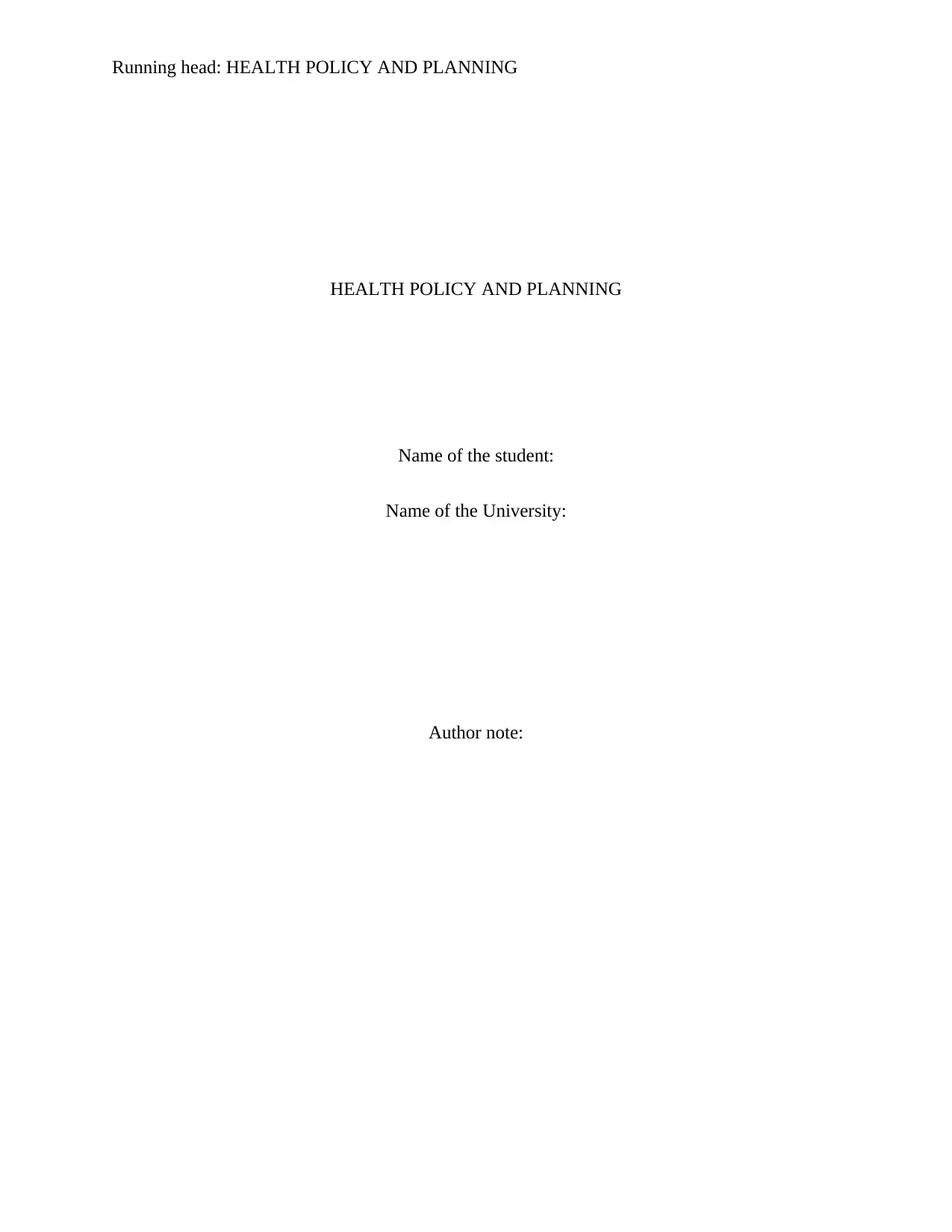
Running head: HEALTH POLICY AND PLANNING
HEALTH POLICY AND PLANNING
Name of the student:
Name of the University:
Author note:
HEALTH POLICY AND PLANNING
Name of the student:
Name of the University:
Author note:
Paraphrase This Document
Need a fresh take? Get an instant paraphrase of this document with our AI Paraphraser
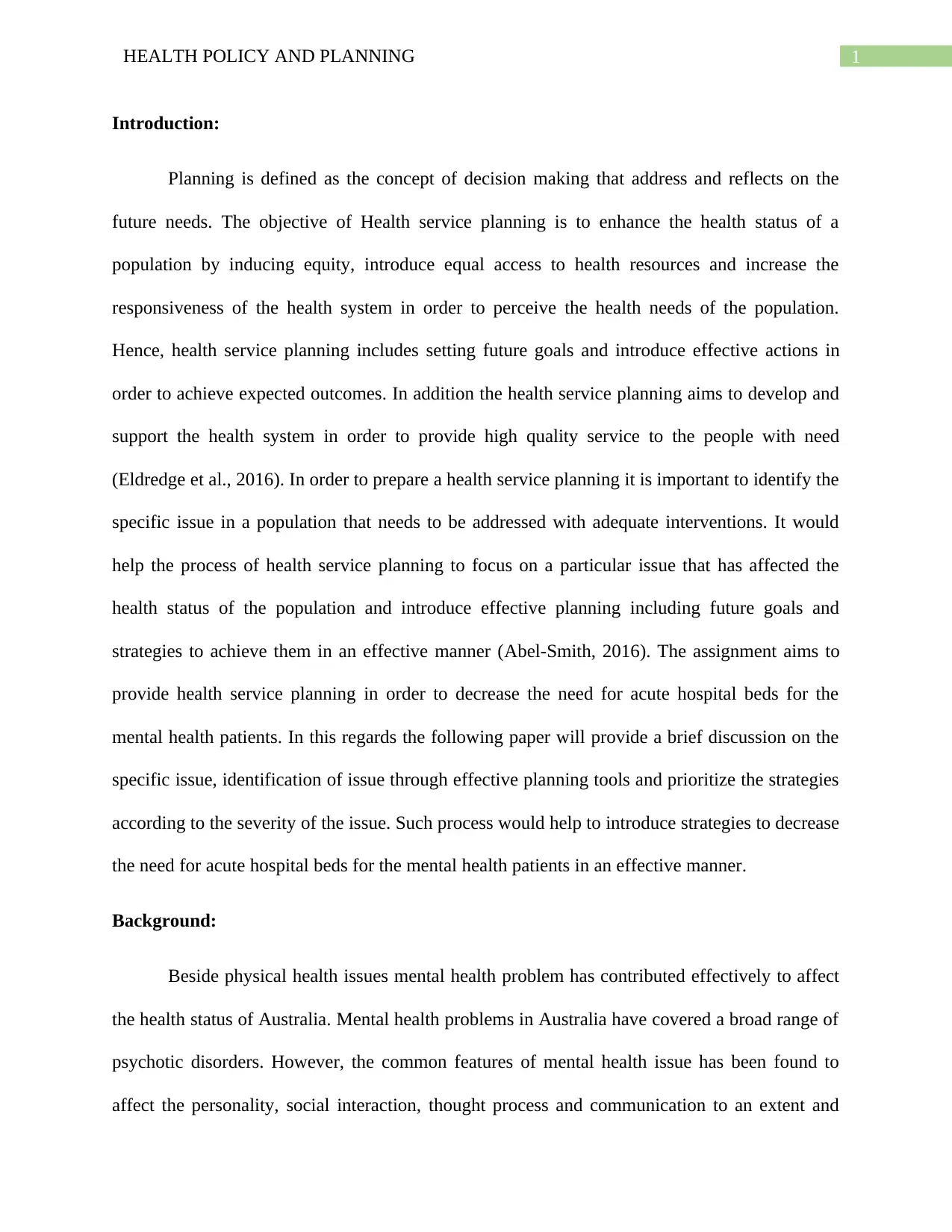
1HEALTH POLICY AND PLANNING
Introduction:
Planning is defined as the concept of decision making that address and reflects on the
future needs. The objective of Health service planning is to enhance the health status of a
population by inducing equity, introduce equal access to health resources and increase the
responsiveness of the health system in order to perceive the health needs of the population.
Hence, health service planning includes setting future goals and introduce effective actions in
order to achieve expected outcomes. In addition the health service planning aims to develop and
support the health system in order to provide high quality service to the people with need
(Eldredge et al., 2016). In order to prepare a health service planning it is important to identify the
specific issue in a population that needs to be addressed with adequate interventions. It would
help the process of health service planning to focus on a particular issue that has affected the
health status of the population and introduce effective planning including future goals and
strategies to achieve them in an effective manner (Abel-Smith, 2016). The assignment aims to
provide health service planning in order to decrease the need for acute hospital beds for the
mental health patients. In this regards the following paper will provide a brief discussion on the
specific issue, identification of issue through effective planning tools and prioritize the strategies
according to the severity of the issue. Such process would help to introduce strategies to decrease
the need for acute hospital beds for the mental health patients in an effective manner.
Background:
Beside physical health issues mental health problem has contributed effectively to affect
the health status of Australia. Mental health problems in Australia have covered a broad range of
psychotic disorders. However, the common features of mental health issue has been found to
affect the personality, social interaction, thought process and communication to an extent and
Introduction:
Planning is defined as the concept of decision making that address and reflects on the
future needs. The objective of Health service planning is to enhance the health status of a
population by inducing equity, introduce equal access to health resources and increase the
responsiveness of the health system in order to perceive the health needs of the population.
Hence, health service planning includes setting future goals and introduce effective actions in
order to achieve expected outcomes. In addition the health service planning aims to develop and
support the health system in order to provide high quality service to the people with need
(Eldredge et al., 2016). In order to prepare a health service planning it is important to identify the
specific issue in a population that needs to be addressed with adequate interventions. It would
help the process of health service planning to focus on a particular issue that has affected the
health status of the population and introduce effective planning including future goals and
strategies to achieve them in an effective manner (Abel-Smith, 2016). The assignment aims to
provide health service planning in order to decrease the need for acute hospital beds for the
mental health patients. In this regards the following paper will provide a brief discussion on the
specific issue, identification of issue through effective planning tools and prioritize the strategies
according to the severity of the issue. Such process would help to introduce strategies to decrease
the need for acute hospital beds for the mental health patients in an effective manner.
Background:
Beside physical health issues mental health problem has contributed effectively to affect
the health status of Australia. Mental health problems in Australia have covered a broad range of
psychotic disorders. However, the common features of mental health issue has been found to
affect the personality, social interaction, thought process and communication to an extent and
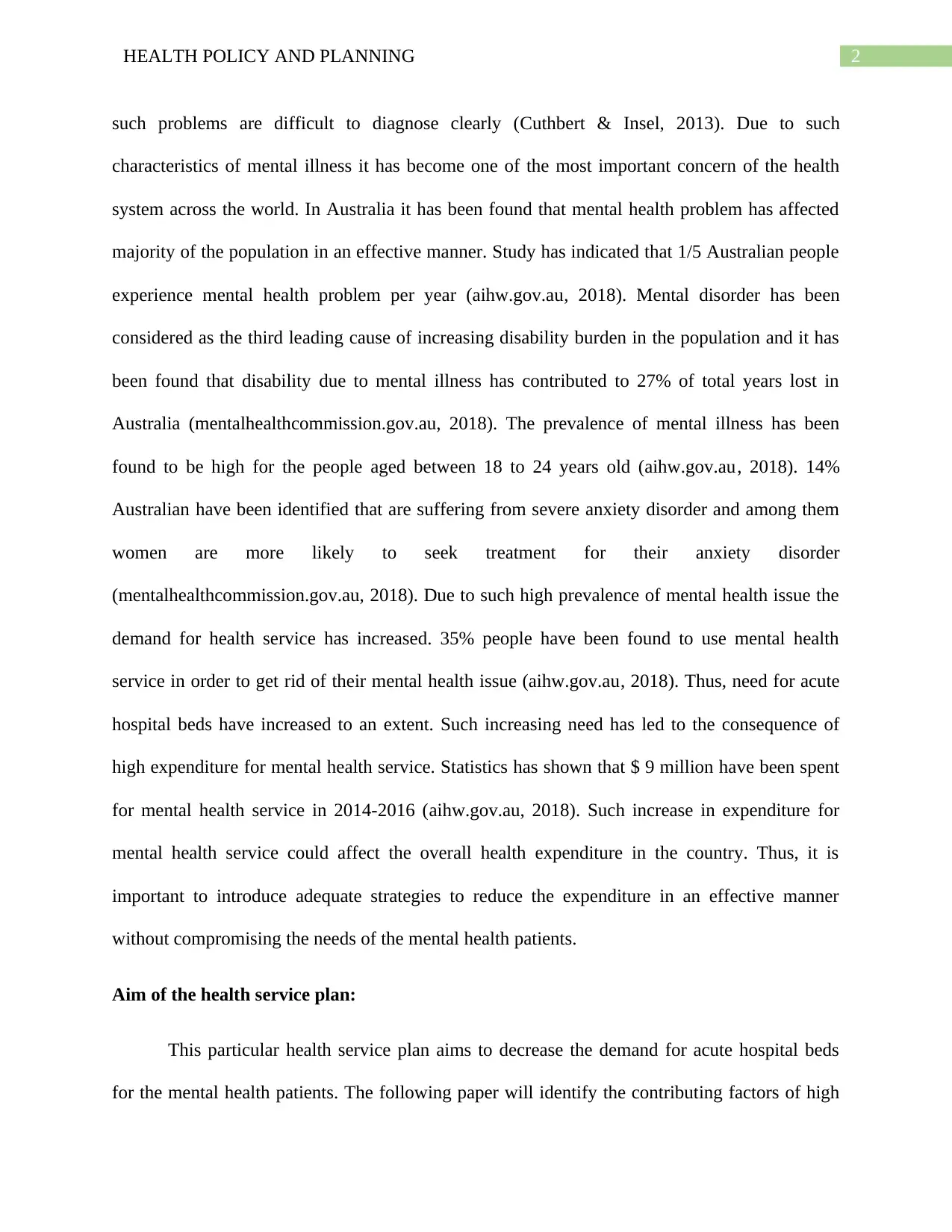
2HEALTH POLICY AND PLANNING
such problems are difficult to diagnose clearly (Cuthbert & Insel, 2013). Due to such
characteristics of mental illness it has become one of the most important concern of the health
system across the world. In Australia it has been found that mental health problem has affected
majority of the population in an effective manner. Study has indicated that 1/5 Australian people
experience mental health problem per year (aihw.gov.au, 2018). Mental disorder has been
considered as the third leading cause of increasing disability burden in the population and it has
been found that disability due to mental illness has contributed to 27% of total years lost in
Australia (mentalhealthcommission.gov.au, 2018). The prevalence of mental illness has been
found to be high for the people aged between 18 to 24 years old (aihw.gov.au, 2018). 14%
Australian have been identified that are suffering from severe anxiety disorder and among them
women are more likely to seek treatment for their anxiety disorder
(mentalhealthcommission.gov.au, 2018). Due to such high prevalence of mental health issue the
demand for health service has increased. 35% people have been found to use mental health
service in order to get rid of their mental health issue (aihw.gov.au, 2018). Thus, need for acute
hospital beds have increased to an extent. Such increasing need has led to the consequence of
high expenditure for mental health service. Statistics has shown that $ 9 million have been spent
for mental health service in 2014-2016 (aihw.gov.au, 2018). Such increase in expenditure for
mental health service could affect the overall health expenditure in the country. Thus, it is
important to introduce adequate strategies to reduce the expenditure in an effective manner
without compromising the needs of the mental health patients.
Aim of the health service plan:
This particular health service plan aims to decrease the demand for acute hospital beds
for the mental health patients. The following paper will identify the contributing factors of high
such problems are difficult to diagnose clearly (Cuthbert & Insel, 2013). Due to such
characteristics of mental illness it has become one of the most important concern of the health
system across the world. In Australia it has been found that mental health problem has affected
majority of the population in an effective manner. Study has indicated that 1/5 Australian people
experience mental health problem per year (aihw.gov.au, 2018). Mental disorder has been
considered as the third leading cause of increasing disability burden in the population and it has
been found that disability due to mental illness has contributed to 27% of total years lost in
Australia (mentalhealthcommission.gov.au, 2018). The prevalence of mental illness has been
found to be high for the people aged between 18 to 24 years old (aihw.gov.au, 2018). 14%
Australian have been identified that are suffering from severe anxiety disorder and among them
women are more likely to seek treatment for their anxiety disorder
(mentalhealthcommission.gov.au, 2018). Due to such high prevalence of mental health issue the
demand for health service has increased. 35% people have been found to use mental health
service in order to get rid of their mental health issue (aihw.gov.au, 2018). Thus, need for acute
hospital beds have increased to an extent. Such increasing need has led to the consequence of
high expenditure for mental health service. Statistics has shown that $ 9 million have been spent
for mental health service in 2014-2016 (aihw.gov.au, 2018). Such increase in expenditure for
mental health service could affect the overall health expenditure in the country. Thus, it is
important to introduce adequate strategies to reduce the expenditure in an effective manner
without compromising the needs of the mental health patients.
Aim of the health service plan:
This particular health service plan aims to decrease the demand for acute hospital beds
for the mental health patients. The following paper will identify the contributing factors of high
⊘ This is a preview!⊘
Do you want full access?
Subscribe today to unlock all pages.

Trusted by 1+ million students worldwide
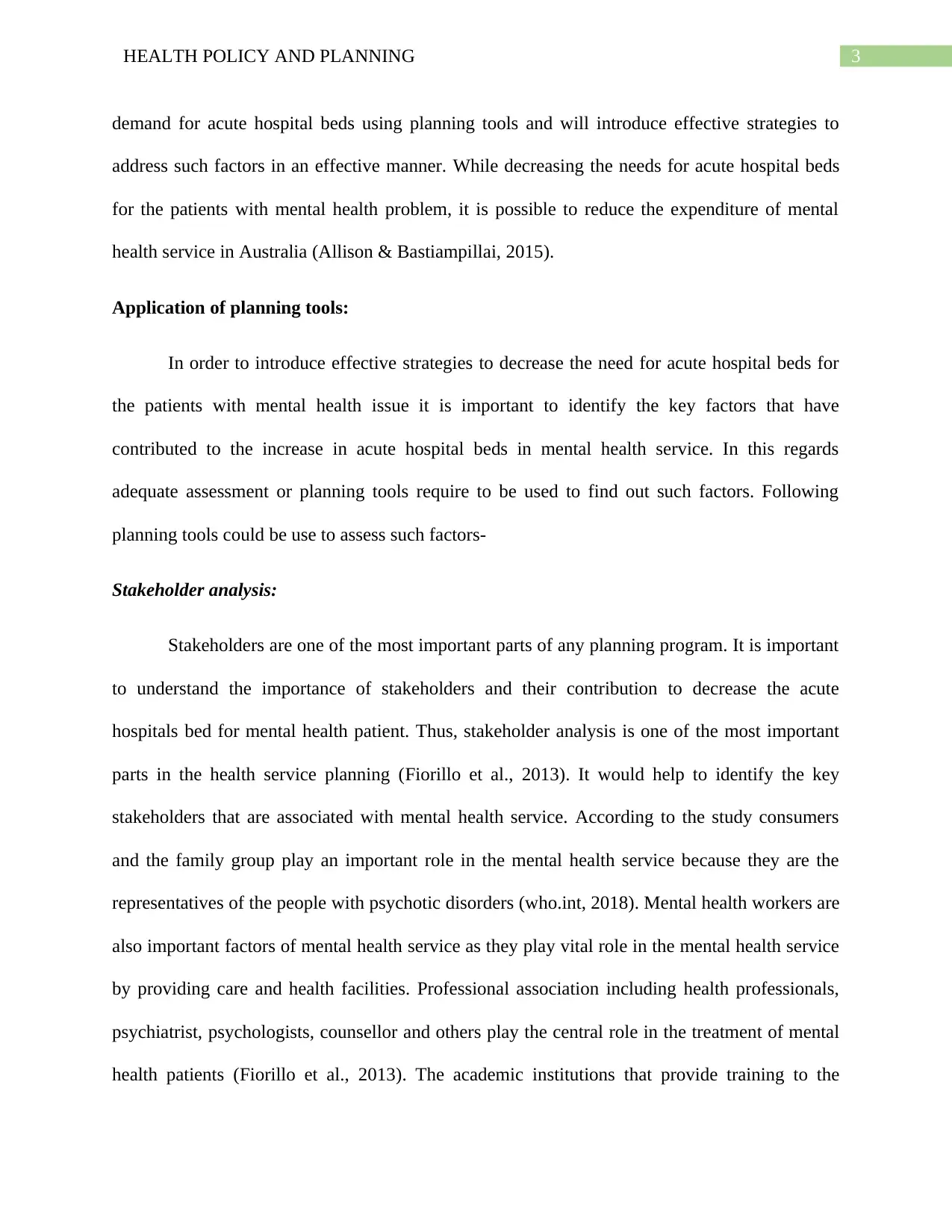
3HEALTH POLICY AND PLANNING
demand for acute hospital beds using planning tools and will introduce effective strategies to
address such factors in an effective manner. While decreasing the needs for acute hospital beds
for the patients with mental health problem, it is possible to reduce the expenditure of mental
health service in Australia (Allison & Bastiampillai, 2015).
Application of planning tools:
In order to introduce effective strategies to decrease the need for acute hospital beds for
the patients with mental health issue it is important to identify the key factors that have
contributed to the increase in acute hospital beds in mental health service. In this regards
adequate assessment or planning tools require to be used to find out such factors. Following
planning tools could be use to assess such factors-
Stakeholder analysis:
Stakeholders are one of the most important parts of any planning program. It is important
to understand the importance of stakeholders and their contribution to decrease the acute
hospitals bed for mental health patient. Thus, stakeholder analysis is one of the most important
parts in the health service planning (Fiorillo et al., 2013). It would help to identify the key
stakeholders that are associated with mental health service. According to the study consumers
and the family group play an important role in the mental health service because they are the
representatives of the people with psychotic disorders (who.int, 2018). Mental health workers are
also important factors of mental health service as they play vital role in the mental health service
by providing care and health facilities. Professional association including health professionals,
psychiatrist, psychologists, counsellor and others play the central role in the treatment of mental
health patients (Fiorillo et al., 2013). The academic institutions that provide training to the
demand for acute hospital beds using planning tools and will introduce effective strategies to
address such factors in an effective manner. While decreasing the needs for acute hospital beds
for the patients with mental health problem, it is possible to reduce the expenditure of mental
health service in Australia (Allison & Bastiampillai, 2015).
Application of planning tools:
In order to introduce effective strategies to decrease the need for acute hospital beds for
the patients with mental health issue it is important to identify the key factors that have
contributed to the increase in acute hospital beds in mental health service. In this regards
adequate assessment or planning tools require to be used to find out such factors. Following
planning tools could be use to assess such factors-
Stakeholder analysis:
Stakeholders are one of the most important parts of any planning program. It is important
to understand the importance of stakeholders and their contribution to decrease the acute
hospitals bed for mental health patient. Thus, stakeholder analysis is one of the most important
parts in the health service planning (Fiorillo et al., 2013). It would help to identify the key
stakeholders that are associated with mental health service. According to the study consumers
and the family group play an important role in the mental health service because they are the
representatives of the people with psychotic disorders (who.int, 2018). Mental health workers are
also important factors of mental health service as they play vital role in the mental health service
by providing care and health facilities. Professional association including health professionals,
psychiatrist, psychologists, counsellor and others play the central role in the treatment of mental
health patients (Fiorillo et al., 2013). The academic institutions that provide training to the
Paraphrase This Document
Need a fresh take? Get an instant paraphrase of this document with our AI Paraphraser

4HEALTH POLICY AND PLANNING
mental health workers and professionals contribute to the mental health service in an effective
manner (who.int, 2018). Government agencies are also important in mental health service as they
provide policies, financial support, health education and social welfare to facilitate the mental
health service (Fiorillo et al., 2013). Nongovernmental agencies also engage in different works
associated with mental health service. In addition traditional health workers and some religious
organizations are also involved in effective mental health service (who.int, 2018).
Strategies should include the involvement of most powerful stakeholder and reduce the
power of some stakeholders that could affect the medical care of the mental health patients. The
most powerful stakeholder in this case is the consumers and their family as the recovery of
mental health issue depends on their interest, thus it is important to educate the consumers and
their families so that they could understand the importance mental health and well-being and
access adequate care in their own interest (Kidd, Kenny & McKinstry, 2015).
Need assessment:
Health need assessment is another important tool that helps in resource allocation. Need
assessment is required to identify the needs of the population in an effective manner. It helps to
maximize the health benefits through most efficient allocation of health resources. In addition it
could help to mitigate the disputes of health resource allocation (Hebebrand et al., 2016). It has
been found that when demands of the consumers are not going to be perceived due to the
distribution of the health resources it is important to identify the health needs of the population in
order to prioritise the health and distribute resources according to the health needs (Paniagua &
Yamada, 2013). Study has reported that lack of awareness regarding the importance of mental
well-being people fail to maintain healthy mental status (Hebebrand et al., 2016). Changes in
lifestyle, environment, social condition and economy level of stress have been found to be
mental health workers and professionals contribute to the mental health service in an effective
manner (who.int, 2018). Government agencies are also important in mental health service as they
provide policies, financial support, health education and social welfare to facilitate the mental
health service (Fiorillo et al., 2013). Nongovernmental agencies also engage in different works
associated with mental health service. In addition traditional health workers and some religious
organizations are also involved in effective mental health service (who.int, 2018).
Strategies should include the involvement of most powerful stakeholder and reduce the
power of some stakeholders that could affect the medical care of the mental health patients. The
most powerful stakeholder in this case is the consumers and their family as the recovery of
mental health issue depends on their interest, thus it is important to educate the consumers and
their families so that they could understand the importance mental health and well-being and
access adequate care in their own interest (Kidd, Kenny & McKinstry, 2015).
Need assessment:
Health need assessment is another important tool that helps in resource allocation. Need
assessment is required to identify the needs of the population in an effective manner. It helps to
maximize the health benefits through most efficient allocation of health resources. In addition it
could help to mitigate the disputes of health resource allocation (Hebebrand et al., 2016). It has
been found that when demands of the consumers are not going to be perceived due to the
distribution of the health resources it is important to identify the health needs of the population in
order to prioritise the health and distribute resources according to the health needs (Paniagua &
Yamada, 2013). Study has reported that lack of awareness regarding the importance of mental
well-being people fail to maintain healthy mental status (Hebebrand et al., 2016). Changes in
lifestyle, environment, social condition and economy level of stress have been found to be

5HEALTH POLICY AND PLANNING
increase in an effective manner. On the other hand depression and anxiety have played an
important role in the development of mental health issue (Paniagua & Yamada, 2013). Thus,
need for mental health education has increased. It has been found that symptoms of mental
illness are difficult to diagnose clearly in early stage thus, most of the mild mental illness leads to
the consequence of acute mental health issue and need for hospitalisation increases (Hebebrand
et al., 2016). Hence, it is required to introduce effective diagnosis process. Additionally, patients
have reported about waiting for a long time for diagnosis that delays the treatment process
(abc.net.au, 2018). Thus, management and technologies need to be improved to reduce the
waiting time of the patient and avoid delay in treatment (Hebebrand et al., 2016).
SWOT analysis:
Strength: The main strength of mental health service in Australia has been found to be the
adequate resources such as availability of mental health organizations, support of mental health
workers, mental health specialists, NGOs and effective mental health policies and financial
support provided by the government. Such resources have helped to provide efficient service to
the people with need (Schmied et al., 2013). Hence, resource management strategy should be
included to increase the strength effectively (Allison & Bastiampillai, 2015).
Weakness: Adequate resources are available however, the allocation of resources is not
effective. In Australia the indigenous people lack the access to adequate health resources due to
social disadvantages. In addition they lack health education that leads to lack of management of
mental well-being. Due to such situation they fail to identify the early signs and symptoms of
mental disorder that leads to the condition of acute mental illness (Andrade et al., 2014). Hence,
the strategy should be appropriate resource allocation and health education for the people to
resolve the weakness (Allison & Bastiampillai, 2015).
increase in an effective manner. On the other hand depression and anxiety have played an
important role in the development of mental health issue (Paniagua & Yamada, 2013). Thus,
need for mental health education has increased. It has been found that symptoms of mental
illness are difficult to diagnose clearly in early stage thus, most of the mild mental illness leads to
the consequence of acute mental health issue and need for hospitalisation increases (Hebebrand
et al., 2016). Hence, it is required to introduce effective diagnosis process. Additionally, patients
have reported about waiting for a long time for diagnosis that delays the treatment process
(abc.net.au, 2018). Thus, management and technologies need to be improved to reduce the
waiting time of the patient and avoid delay in treatment (Hebebrand et al., 2016).
SWOT analysis:
Strength: The main strength of mental health service in Australia has been found to be the
adequate resources such as availability of mental health organizations, support of mental health
workers, mental health specialists, NGOs and effective mental health policies and financial
support provided by the government. Such resources have helped to provide efficient service to
the people with need (Schmied et al., 2013). Hence, resource management strategy should be
included to increase the strength effectively (Allison & Bastiampillai, 2015).
Weakness: Adequate resources are available however, the allocation of resources is not
effective. In Australia the indigenous people lack the access to adequate health resources due to
social disadvantages. In addition they lack health education that leads to lack of management of
mental well-being. Due to such situation they fail to identify the early signs and symptoms of
mental disorder that leads to the condition of acute mental illness (Andrade et al., 2014). Hence,
the strategy should be appropriate resource allocation and health education for the people to
resolve the weakness (Allison & Bastiampillai, 2015).
⊘ This is a preview!⊘
Do you want full access?
Subscribe today to unlock all pages.

Trusted by 1+ million students worldwide
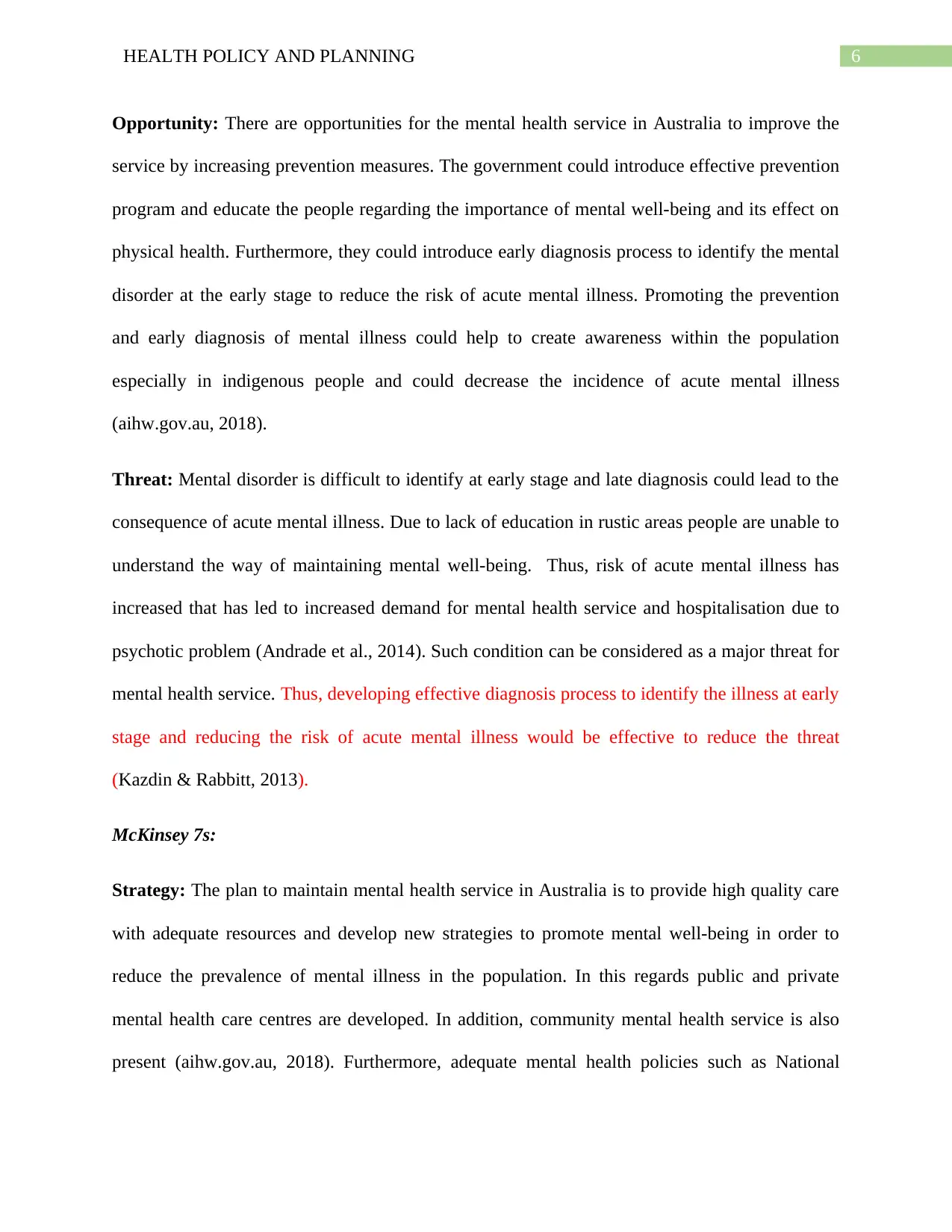
6HEALTH POLICY AND PLANNING
Opportunity: There are opportunities for the mental health service in Australia to improve the
service by increasing prevention measures. The government could introduce effective prevention
program and educate the people regarding the importance of mental well-being and its effect on
physical health. Furthermore, they could introduce early diagnosis process to identify the mental
disorder at the early stage to reduce the risk of acute mental illness. Promoting the prevention
and early diagnosis of mental illness could help to create awareness within the population
especially in indigenous people and could decrease the incidence of acute mental illness
(aihw.gov.au, 2018).
Threat: Mental disorder is difficult to identify at early stage and late diagnosis could lead to the
consequence of acute mental illness. Due to lack of education in rustic areas people are unable to
understand the way of maintaining mental well-being. Thus, risk of acute mental illness has
increased that has led to increased demand for mental health service and hospitalisation due to
psychotic problem (Andrade et al., 2014). Such condition can be considered as a major threat for
mental health service. Thus, developing effective diagnosis process to identify the illness at early
stage and reducing the risk of acute mental illness would be effective to reduce the threat
(Kazdin & Rabbitt, 2013).
McKinsey 7s:
Strategy: The plan to maintain mental health service in Australia is to provide high quality care
with adequate resources and develop new strategies to promote mental well-being in order to
reduce the prevalence of mental illness in the population. In this regards public and private
mental health care centres are developed. In addition, community mental health service is also
present (aihw.gov.au, 2018). Furthermore, adequate mental health policies such as National
Opportunity: There are opportunities for the mental health service in Australia to improve the
service by increasing prevention measures. The government could introduce effective prevention
program and educate the people regarding the importance of mental well-being and its effect on
physical health. Furthermore, they could introduce early diagnosis process to identify the mental
disorder at the early stage to reduce the risk of acute mental illness. Promoting the prevention
and early diagnosis of mental illness could help to create awareness within the population
especially in indigenous people and could decrease the incidence of acute mental illness
(aihw.gov.au, 2018).
Threat: Mental disorder is difficult to identify at early stage and late diagnosis could lead to the
consequence of acute mental illness. Due to lack of education in rustic areas people are unable to
understand the way of maintaining mental well-being. Thus, risk of acute mental illness has
increased that has led to increased demand for mental health service and hospitalisation due to
psychotic problem (Andrade et al., 2014). Such condition can be considered as a major threat for
mental health service. Thus, developing effective diagnosis process to identify the illness at early
stage and reducing the risk of acute mental illness would be effective to reduce the threat
(Kazdin & Rabbitt, 2013).
McKinsey 7s:
Strategy: The plan to maintain mental health service in Australia is to provide high quality care
with adequate resources and develop new strategies to promote mental well-being in order to
reduce the prevalence of mental illness in the population. In this regards public and private
mental health care centres are developed. In addition, community mental health service is also
present (aihw.gov.au, 2018). Furthermore, adequate mental health policies such as National
Paraphrase This Document
Need a fresh take? Get an instant paraphrase of this document with our AI Paraphraser
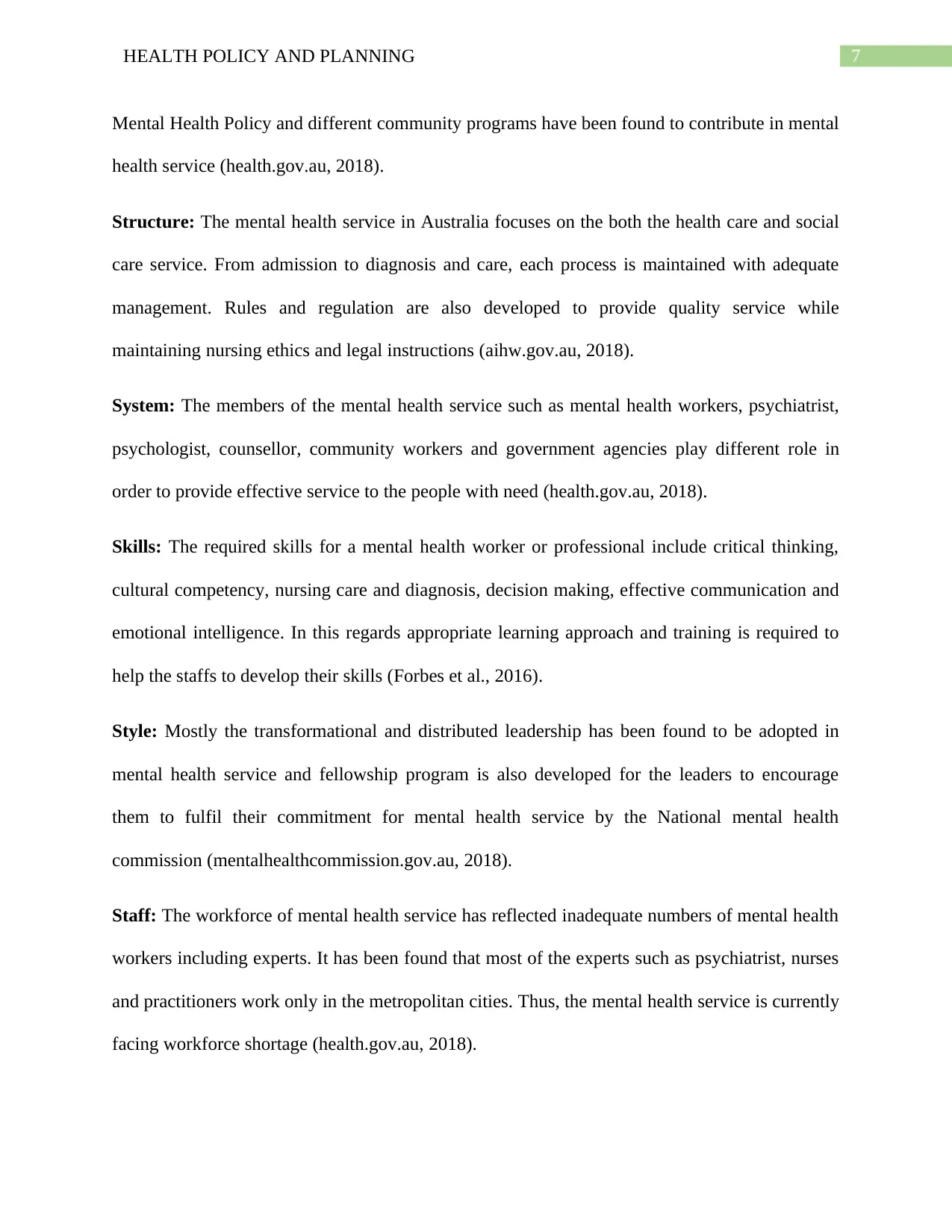
7HEALTH POLICY AND PLANNING
Mental Health Policy and different community programs have been found to contribute in mental
health service (health.gov.au, 2018).
Structure: The mental health service in Australia focuses on the both the health care and social
care service. From admission to diagnosis and care, each process is maintained with adequate
management. Rules and regulation are also developed to provide quality service while
maintaining nursing ethics and legal instructions (aihw.gov.au, 2018).
System: The members of the mental health service such as mental health workers, psychiatrist,
psychologist, counsellor, community workers and government agencies play different role in
order to provide effective service to the people with need (health.gov.au, 2018).
Skills: The required skills for a mental health worker or professional include critical thinking,
cultural competency, nursing care and diagnosis, decision making, effective communication and
emotional intelligence. In this regards appropriate learning approach and training is required to
help the staffs to develop their skills (Forbes et al., 2016).
Style: Mostly the transformational and distributed leadership has been found to be adopted in
mental health service and fellowship program is also developed for the leaders to encourage
them to fulfil their commitment for mental health service by the National mental health
commission (mentalhealthcommission.gov.au, 2018).
Staff: The workforce of mental health service has reflected inadequate numbers of mental health
workers including experts. It has been found that most of the experts such as psychiatrist, nurses
and practitioners work only in the metropolitan cities. Thus, the mental health service is currently
facing workforce shortage (health.gov.au, 2018).
Mental Health Policy and different community programs have been found to contribute in mental
health service (health.gov.au, 2018).
Structure: The mental health service in Australia focuses on the both the health care and social
care service. From admission to diagnosis and care, each process is maintained with adequate
management. Rules and regulation are also developed to provide quality service while
maintaining nursing ethics and legal instructions (aihw.gov.au, 2018).
System: The members of the mental health service such as mental health workers, psychiatrist,
psychologist, counsellor, community workers and government agencies play different role in
order to provide effective service to the people with need (health.gov.au, 2018).
Skills: The required skills for a mental health worker or professional include critical thinking,
cultural competency, nursing care and diagnosis, decision making, effective communication and
emotional intelligence. In this regards appropriate learning approach and training is required to
help the staffs to develop their skills (Forbes et al., 2016).
Style: Mostly the transformational and distributed leadership has been found to be adopted in
mental health service and fellowship program is also developed for the leaders to encourage
them to fulfil their commitment for mental health service by the National mental health
commission (mentalhealthcommission.gov.au, 2018).
Staff: The workforce of mental health service has reflected inadequate numbers of mental health
workers including experts. It has been found that most of the experts such as psychiatrist, nurses
and practitioners work only in the metropolitan cities. Thus, the mental health service is currently
facing workforce shortage (health.gov.au, 2018).

8HEALTH POLICY AND PLANNING
Shared values: The superordinate goals include the encouraging the mental health workforce to
cooperate with each other and provide high quality service. In this regards it has been found that
there is lack of collaboration between the primary health care service and specialist mental health
service in Australia (health.gov.au, 2018). Thus, it is important to improve the collaboration to
develop shared values in order to meet the requirement of the population regarding mental
health.
The lack of coordination between primary health care service and specialist mental health
service, workforce shortage and lack of interest of the specialist mental health professionals to
work outside the metropolitan cities have affected the alignment between these 7 aspects. Hence,
the first strategy should be to improve the collaboration between primary health care service and
specialist mental health service and training may be helpful in this case (Allison & Bastiampillai,
2015). Second strategy should be introducing regulation on practice mental health of the
professionals so that they show interest to provide service outside the metropolitan cities and
improving policies and incentive structure for improving employee retention plan is required
(Whiteford, Harris & Diminic, 2013).
Strategies:
Application of planning tools have helped to identify the area of priority for development
or introducing effective interventions in order to decrease the need for acute hospital beds for
mental health patients. In this regards the first strategy should be to improve the primary mental
health service and diagnosis process of mental illness. This is because early diagnosis and
effective treatment at primary care level could reduce the risk of acute stage of mental illness,
thus, hospitalisation for acute mental health problem will be reduced, which may lead to the
reduction in the demand for acute hospital beds (Kazdin & Rabbitt, 2013). Prevention plan for
Shared values: The superordinate goals include the encouraging the mental health workforce to
cooperate with each other and provide high quality service. In this regards it has been found that
there is lack of collaboration between the primary health care service and specialist mental health
service in Australia (health.gov.au, 2018). Thus, it is important to improve the collaboration to
develop shared values in order to meet the requirement of the population regarding mental
health.
The lack of coordination between primary health care service and specialist mental health
service, workforce shortage and lack of interest of the specialist mental health professionals to
work outside the metropolitan cities have affected the alignment between these 7 aspects. Hence,
the first strategy should be to improve the collaboration between primary health care service and
specialist mental health service and training may be helpful in this case (Allison & Bastiampillai,
2015). Second strategy should be introducing regulation on practice mental health of the
professionals so that they show interest to provide service outside the metropolitan cities and
improving policies and incentive structure for improving employee retention plan is required
(Whiteford, Harris & Diminic, 2013).
Strategies:
Application of planning tools have helped to identify the area of priority for development
or introducing effective interventions in order to decrease the need for acute hospital beds for
mental health patients. In this regards the first strategy should be to improve the primary mental
health service and diagnosis process of mental illness. This is because early diagnosis and
effective treatment at primary care level could reduce the risk of acute stage of mental illness,
thus, hospitalisation for acute mental health problem will be reduced, which may lead to the
reduction in the demand for acute hospital beds (Kazdin & Rabbitt, 2013). Prevention plan for
⊘ This is a preview!⊘
Do you want full access?
Subscribe today to unlock all pages.

Trusted by 1+ million students worldwide
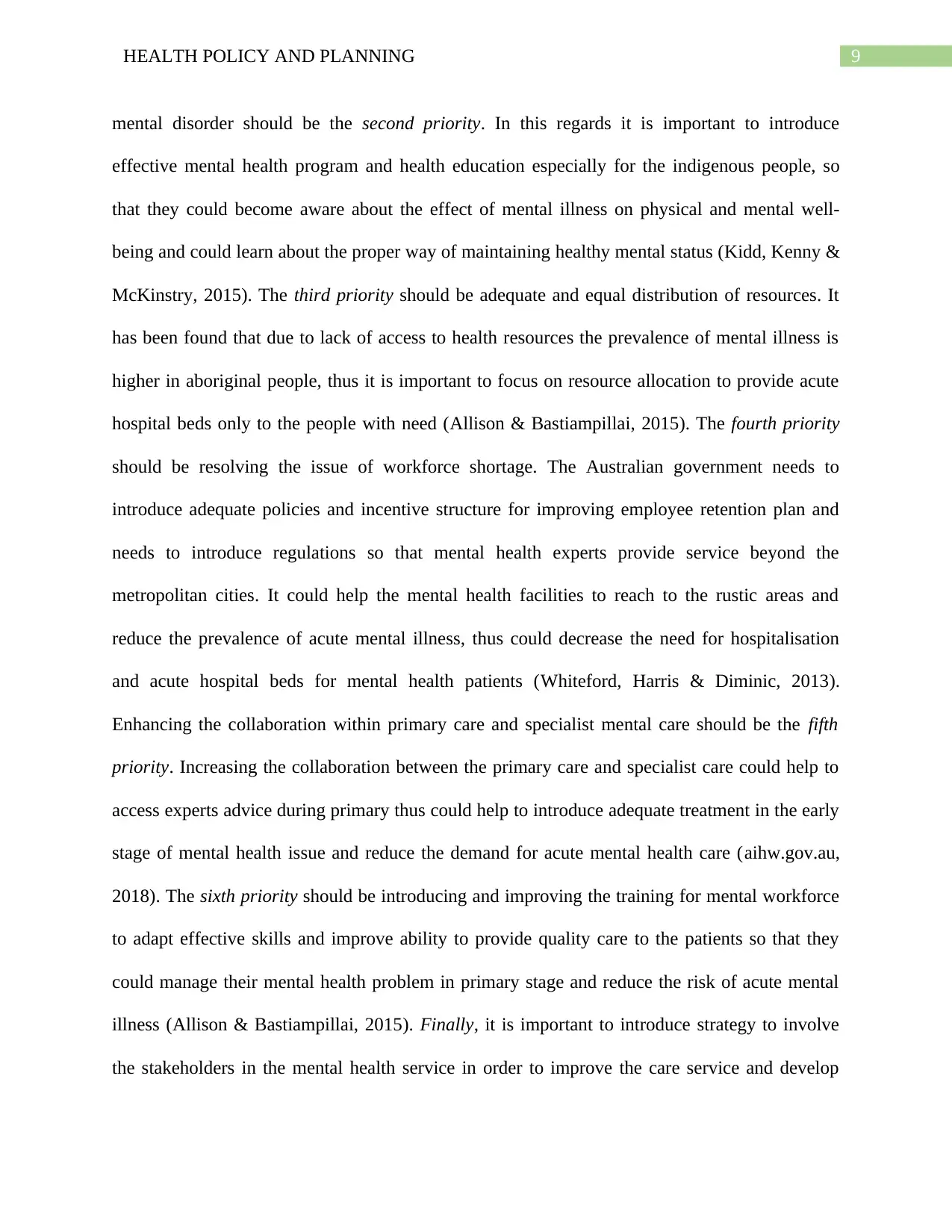
9HEALTH POLICY AND PLANNING
mental disorder should be the second priority. In this regards it is important to introduce
effective mental health program and health education especially for the indigenous people, so
that they could become aware about the effect of mental illness on physical and mental well-
being and could learn about the proper way of maintaining healthy mental status (Kidd, Kenny &
McKinstry, 2015). The third priority should be adequate and equal distribution of resources. It
has been found that due to lack of access to health resources the prevalence of mental illness is
higher in aboriginal people, thus it is important to focus on resource allocation to provide acute
hospital beds only to the people with need (Allison & Bastiampillai, 2015). The fourth priority
should be resolving the issue of workforce shortage. The Australian government needs to
introduce adequate policies and incentive structure for improving employee retention plan and
needs to introduce regulations so that mental health experts provide service beyond the
metropolitan cities. It could help the mental health facilities to reach to the rustic areas and
reduce the prevalence of acute mental illness, thus could decrease the need for hospitalisation
and acute hospital beds for mental health patients (Whiteford, Harris & Diminic, 2013).
Enhancing the collaboration within primary care and specialist mental care should be the fifth
priority. Increasing the collaboration between the primary care and specialist care could help to
access experts advice during primary thus could help to introduce adequate treatment in the early
stage of mental health issue and reduce the demand for acute mental health care (aihw.gov.au,
2018). The sixth priority should be introducing and improving the training for mental workforce
to adapt effective skills and improve ability to provide quality care to the patients so that they
could manage their mental health problem in primary stage and reduce the risk of acute mental
illness (Allison & Bastiampillai, 2015). Finally, it is important to introduce strategy to involve
the stakeholders in the mental health service in order to improve the care service and develop
mental disorder should be the second priority. In this regards it is important to introduce
effective mental health program and health education especially for the indigenous people, so
that they could become aware about the effect of mental illness on physical and mental well-
being and could learn about the proper way of maintaining healthy mental status (Kidd, Kenny &
McKinstry, 2015). The third priority should be adequate and equal distribution of resources. It
has been found that due to lack of access to health resources the prevalence of mental illness is
higher in aboriginal people, thus it is important to focus on resource allocation to provide acute
hospital beds only to the people with need (Allison & Bastiampillai, 2015). The fourth priority
should be resolving the issue of workforce shortage. The Australian government needs to
introduce adequate policies and incentive structure for improving employee retention plan and
needs to introduce regulations so that mental health experts provide service beyond the
metropolitan cities. It could help the mental health facilities to reach to the rustic areas and
reduce the prevalence of acute mental illness, thus could decrease the need for hospitalisation
and acute hospital beds for mental health patients (Whiteford, Harris & Diminic, 2013).
Enhancing the collaboration within primary care and specialist mental care should be the fifth
priority. Increasing the collaboration between the primary care and specialist care could help to
access experts advice during primary thus could help to introduce adequate treatment in the early
stage of mental health issue and reduce the demand for acute mental health care (aihw.gov.au,
2018). The sixth priority should be introducing and improving the training for mental workforce
to adapt effective skills and improve ability to provide quality care to the patients so that they
could manage their mental health problem in primary stage and reduce the risk of acute mental
illness (Allison & Bastiampillai, 2015). Finally, it is important to introduce strategy to involve
the stakeholders in the mental health service in order to improve the care service and develop
Paraphrase This Document
Need a fresh take? Get an instant paraphrase of this document with our AI Paraphraser
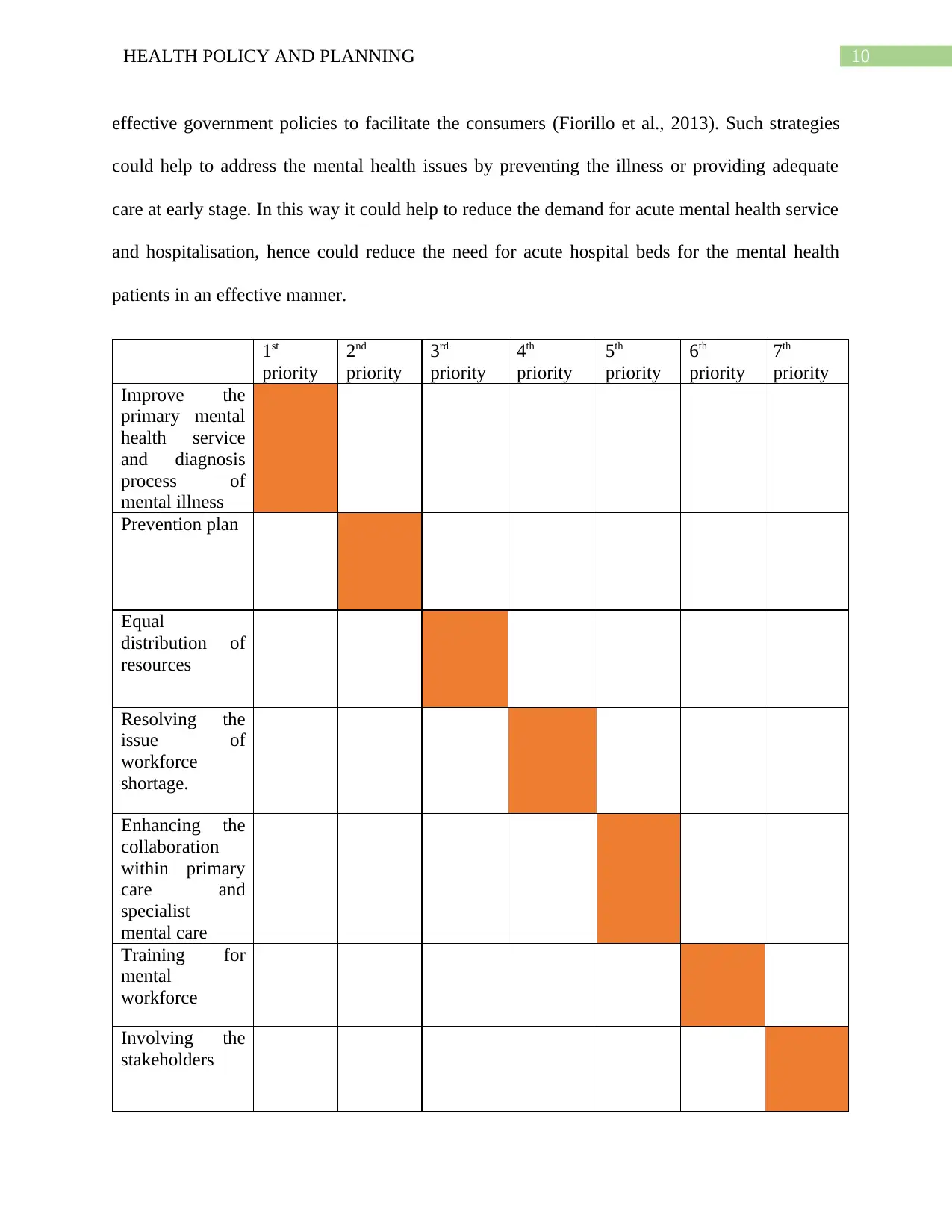
10HEALTH POLICY AND PLANNING
effective government policies to facilitate the consumers (Fiorillo et al., 2013). Such strategies
could help to address the mental health issues by preventing the illness or providing adequate
care at early stage. In this way it could help to reduce the demand for acute mental health service
and hospitalisation, hence could reduce the need for acute hospital beds for the mental health
patients in an effective manner.
1st
priority
2nd
priority
3rd
priority
4th
priority
5th
priority
6th
priority
7th
priority
Improve the
primary mental
health service
and diagnosis
process of
mental illness
Prevention plan
Equal
distribution of
resources
Resolving the
issue of
workforce
shortage.
Enhancing the
collaboration
within primary
care and
specialist
mental care
Training for
mental
workforce
Involving the
stakeholders
effective government policies to facilitate the consumers (Fiorillo et al., 2013). Such strategies
could help to address the mental health issues by preventing the illness or providing adequate
care at early stage. In this way it could help to reduce the demand for acute mental health service
and hospitalisation, hence could reduce the need for acute hospital beds for the mental health
patients in an effective manner.
1st
priority
2nd
priority
3rd
priority
4th
priority
5th
priority
6th
priority
7th
priority
Improve the
primary mental
health service
and diagnosis
process of
mental illness
Prevention plan
Equal
distribution of
resources
Resolving the
issue of
workforce
shortage.
Enhancing the
collaboration
within primary
care and
specialist
mental care
Training for
mental
workforce
Involving the
stakeholders
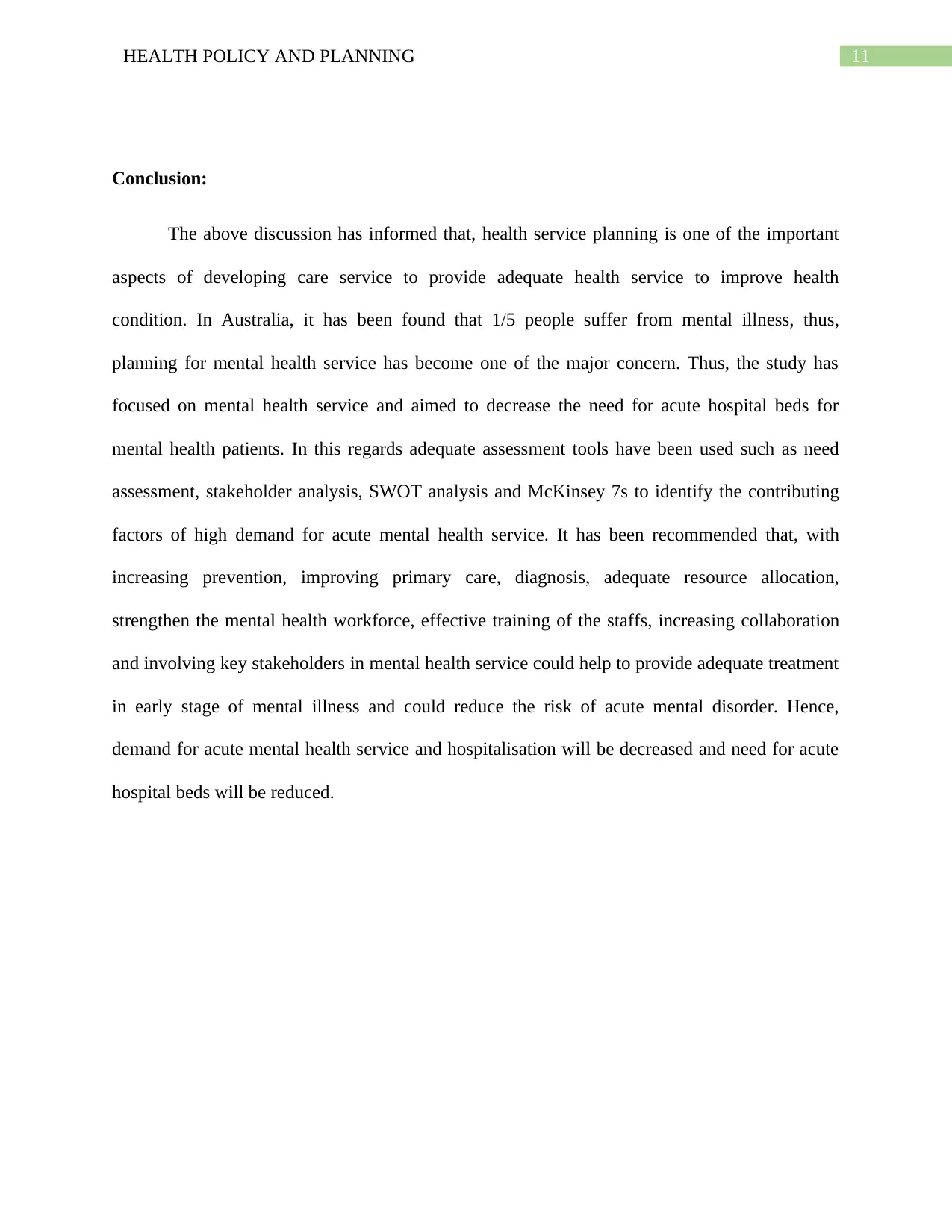
11HEALTH POLICY AND PLANNING
Conclusion:
The above discussion has informed that, health service planning is one of the important
aspects of developing care service to provide adequate health service to improve health
condition. In Australia, it has been found that 1/5 people suffer from mental illness, thus,
planning for mental health service has become one of the major concern. Thus, the study has
focused on mental health service and aimed to decrease the need for acute hospital beds for
mental health patients. In this regards adequate assessment tools have been used such as need
assessment, stakeholder analysis, SWOT analysis and McKinsey 7s to identify the contributing
factors of high demand for acute mental health service. It has been recommended that, with
increasing prevention, improving primary care, diagnosis, adequate resource allocation,
strengthen the mental health workforce, effective training of the staffs, increasing collaboration
and involving key stakeholders in mental health service could help to provide adequate treatment
in early stage of mental illness and could reduce the risk of acute mental disorder. Hence,
demand for acute mental health service and hospitalisation will be decreased and need for acute
hospital beds will be reduced.
Conclusion:
The above discussion has informed that, health service planning is one of the important
aspects of developing care service to provide adequate health service to improve health
condition. In Australia, it has been found that 1/5 people suffer from mental illness, thus,
planning for mental health service has become one of the major concern. Thus, the study has
focused on mental health service and aimed to decrease the need for acute hospital beds for
mental health patients. In this regards adequate assessment tools have been used such as need
assessment, stakeholder analysis, SWOT analysis and McKinsey 7s to identify the contributing
factors of high demand for acute mental health service. It has been recommended that, with
increasing prevention, improving primary care, diagnosis, adequate resource allocation,
strengthen the mental health workforce, effective training of the staffs, increasing collaboration
and involving key stakeholders in mental health service could help to provide adequate treatment
in early stage of mental illness and could reduce the risk of acute mental disorder. Hence,
demand for acute mental health service and hospitalisation will be decreased and need for acute
hospital beds will be reduced.
⊘ This is a preview!⊘
Do you want full access?
Subscribe today to unlock all pages.

Trusted by 1+ million students worldwide
1 out of 16
Related Documents
Your All-in-One AI-Powered Toolkit for Academic Success.
+13062052269
info@desklib.com
Available 24*7 on WhatsApp / Email
![[object Object]](/_next/static/media/star-bottom.7253800d.svg)
Unlock your academic potential
Copyright © 2020–2025 A2Z Services. All Rights Reserved. Developed and managed by ZUCOL.





